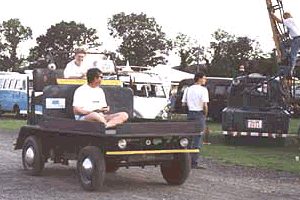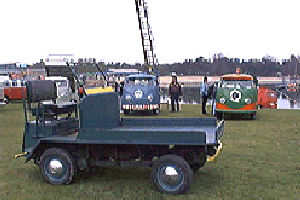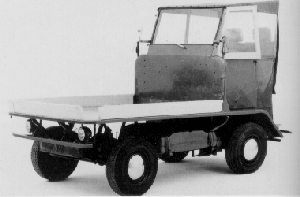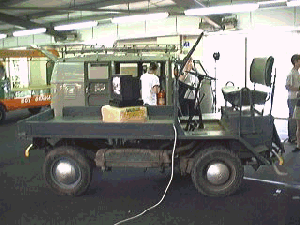
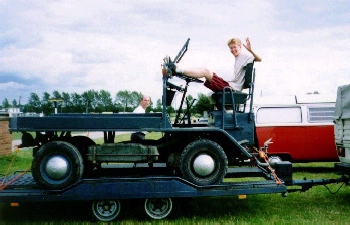 It's late 1940's and the VW plant is trying to get back on it's feet after the war. The most of the small production of Beetles goes directly to the occupying forces as vehicles are a rare comodity. In those early days a Dutch business man called Ben Pon makes some visits to the VW plant. Even before the war he had been keen to become the Dutch importer for VW and now he's back to see what's left of this great car. Much to his delight be becomes the official Dutch VW importer and thus the world first person ever to export a beetle.
It's late 1940's and the VW plant is trying to get back on it's feet after the war. The most of the small production of Beetles goes directly to the occupying forces as vehicles are a rare comodity. In those early days a Dutch business man called Ben Pon makes some visits to the VW plant. Even before the war he had been keen to become the Dutch importer for VW and now he's back to see what's left of this great car. Much to his delight be becomes the official Dutch VW importer and thus the world first person ever to export a beetle.
When Ben Pon is on one of his business trips in early 1947, he sees a curious vehicle driving around the VW plant. The worker have taken a beetle chassis and have covered most of it with a loading area. The drivers seat is moved all the way to the back, above the engine. They call it Plattenwagen which simply means flatbedvehicle
VW have no intention to market this vehicle but Ben Pon sees the potential. The Dutch gouvernement will not qualify this vehicle road worth because of the steering position.
Pon still wants to market a VW with more cargo area and on April 23rd 1947 he used his notebook to make a scetch of the VW bus. It's a simple solution, just move the driver all the way up to the front.
VW likes the idea and makes a prototype in 1949. The production of the Type II starts in 1950 and aircooled busses have been made up to 1982.
At the end of 1996 the Dutch Aircooled VW Club LVWCN and the German splitscreen van club Bulli Kartei started to make some plans for a special commerative weekend to celebrate the 50th anneversary of the Ben Pon Scetch. They realised that it would be great to have a Plattenwagen at the meeting. At the time there were only 2 Plattenwagens known to be still around. 1 in the VW museum in Wolfsburg and 1 in the famous Lottermann collection. Then Bulli Kartei chairman Jochen Brauer has great news, he has just bought an even older Plattenwagen !
The down part to this story is it's poor condition, but the weekend is still far away and Jochen is sure the can finish it in time. Unfortunatly Jochen was to bussy at work to be able to get the work done in time.
The Dutch people on the organising committee propose to bring the Plattenwagen to Holland and to fix it up for the big weekend. So Hans Sprenkels and Herman Brooimans drive to Germany to pick it up. Once they get there in for a bit of a shock as it's in a worse contition as they expected.
Built in 1946 it should have a shortend beetle chassis and running gear. What they find in germany is a shorted splitscreen van chassis with an industrial 30 BHP engine and a bus gearbox with reduction boxes. Even the front axle and steeringbox a from a type II.
This vehicle has been used from 1946 until the early '70's and it has been abused just like any other work vehicle. What would you do if you damaged a part next to piles of brand new VW parts, put on newer and beter parts or try to find the older but correct '46 parts ?
The entire Plattenwagen must have been rebuilt a few times in it's lifetime. The only parts that probaly is still original is the small piece of metal with the chassis number that has been welded onto the splitscreen chassis.
Hans and Herman take the rusty vehicle back home and Hans and Hermans father Wim start restoring it. First step was getting the rust of.This was done with a wirebrush on the good old electric grinder. Most of the Chassis had rust on it, there were only a few spot of paint left. The color was Samt grün (green), but this color wasn't introduced until 1964.
The new paint color was mixed from some old cans of paint. It's slightly more blue, but then again most early busses came in light blue.
The rear seat had to be welded to the engine cover. It's a rather strage bench for 2 people, not like any other VW bench. The Plattenwagen in the museum has 2 sperate seats, but is otherwise almost the same.
The engine is started with a button on the small dashboard, there is no key. The entire engine needed some attention. New sparkplugs, points, cables and coil. The timing and carb had to be adjusted.
The throttle linkage was gone and the oilpressure sensor did no longer work. Fuel can from a petrolcan in the enginebay, so the fuel line from orginal fuel tank had to be restored
The electrical system needed some R&R and some new lights we put on. Only unsolved problem at the Ben Pon Party were the hand brakes. The brake lever is located in a different position, so most cables where to long. These were specially made in time for BVF
After the fun they had a the Pon Party in April they decided that it would be nice to take it to the special commercial vehicles display at BVF. Jochen was already trailering a splitty, so Hans loaded it behind this Synchro and hauled it to the UK.
At both meetings lots of people had a change to drive this unique vehicle and they all enjoyed it a lot. I won't mention any names, but some addicts are going to VW Euro just to drive it again (and agian and agian...)
Driving this thing is really a strange experience. You site on top of the engine, behind the rear axle. It feels like the rear axle does the steering (like on a forklift). If you drive it down a straight line everything is ok, but once it diverts just a little and you try to correct it will only make the diversion even bigger ! It's will get your adrenaline going believe me ! Once you get the hang of it it drives verry well. Theoratically it should go even faster then a beetle (weighs only 300 KG), but Hans hasn't dared to go faster then 70 km/h
